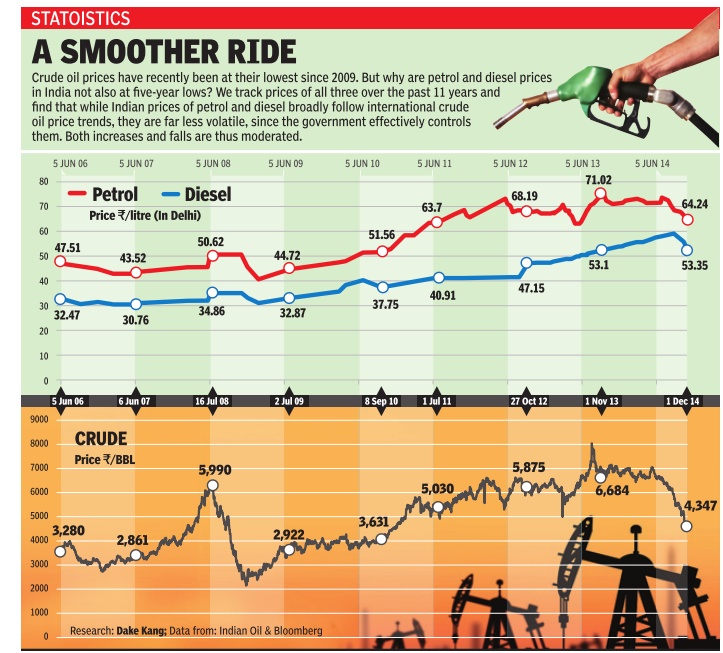Petroleum, diesel, kerosene, India: I
This is a collection of articles archived for the excellence of their content. Readers will be able to edit existing articles and post new articles directly |



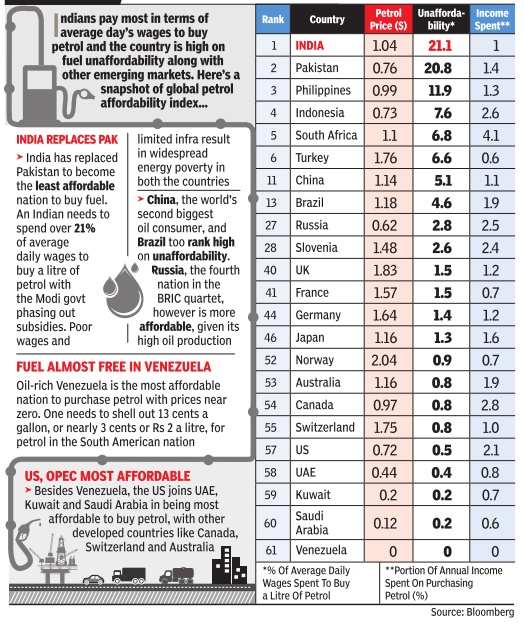
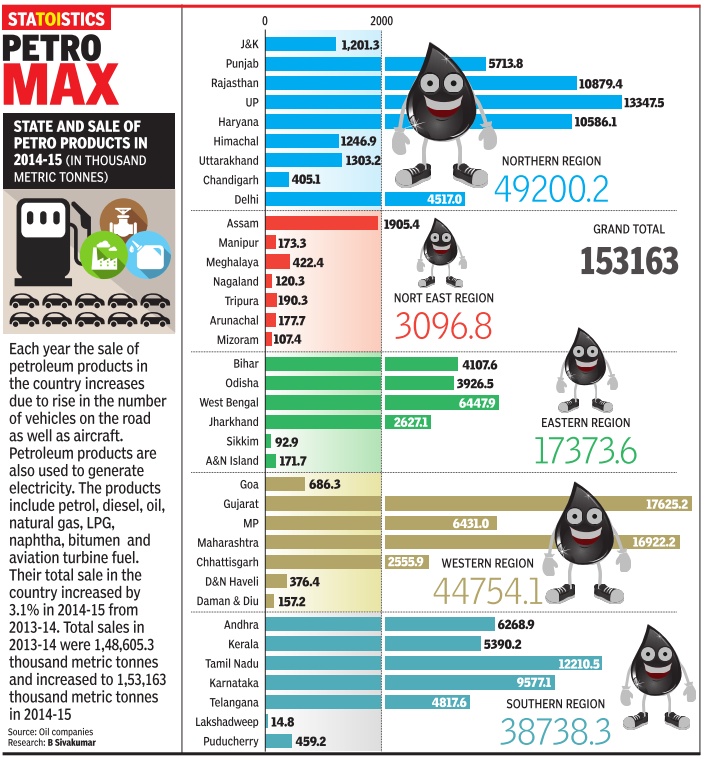
Contents |
Crude oil imports
From Nigeria
Nigeria says India now its largest crude importer
AFP | Jun 19, 2014
Oil-rich Nigeria said in June 2014 that India has replaced the United States as its largest crude importer, accounting for more than a quarter of its daily output.
"The US, which had traditionally taken the bulk of Nigeria's crude, has in recent months drastically reduced its demand, which now stands at about 250,000 barrels per day," the Nigerian National Petroleum Corporation (NNPC) said in a statement.
"India, however, now purchases some 30% of Nigeria's daily crude production which currently hovers around 2.5 million barrels," it said, quoting senior official Tim Okon.
The state-run NNPC said after India, China and Malaysia were also ahead of the United States, and that Nigeria, which is Africa's largest oil producer, would supply to customers around the world.
Diesel consumption in India
2012-13
Over 13% diesel consumed by high-end cars, SUVs in India, study says
PTI | Jan 28, 2014
NEW DELHI: Over 13 per cent of subsidized diesel in the country is consumed by high-end cars and SUVs, says a study commissioned by the oil ministry, showing that cheaper fuel is finding usage by unintended beneficiaries.
A study conducted by Nielsen for the ministry's Petroleum Planning and Analysis Cell (PPAC) found that private cars consumed 13.15 per cent of the 69.08 million tonne diesel consumed in the country in 2012-13.
Commercial vehicles used another 8.94 per cent and three-wheelers, a further 6.39 per cent.
Commercial vehicles such as trucks however constituted the largest user base of diesel at 28.25 per cent, the study said, adding that 70 per cent of the diesel was being used in the transport sector.
Agriculture tractors and pumps used 13 per cent of the diesel.
Industries and electricity generators consumed almost 9 per cent diesel, while mobile towers used 1.54 per cent.
The study found that 99.6 per cent of petrol is consumed in the transport sector alone.
"Of this, majority consumption of 61.42 per cent is accounted for by two-wheelers while cars use 34.33 per cent, followed by 3-wheelers at 2.34 per cent," an official statement said.
It was also revealed that in Odisha, Bihar and Rajasthan, petrol consumption by two-wheelers exceeds 70 per cent.
The consumption by three-wheelers is very low in states like Delhi, Haryana, Gujarat and Odisha, where consumers have shifted to CNG or diesel.
"While pricing of petrol was deregulated, diesel prices are still being regulated, with subsidy running at Rs 8.47 per litre currently," the statement said.
The total subsidy on diesel during 2012-13 was Rs 92,061 crore, constituting 57.2 per cent of the total fuel subsidy.
"The question as to where the Diesel is getting consumed is very relevant in this context," it said.
The statement added: "Based on sector-wise consumption pattern of diesel, it would mean that of the total under- recovery of Rs 92,061 crore on account of diesel during 2012- 13, about Rs 12,100 crore went to owners of private cars and utility vehicles, about Rs 8,200 crore to commercial cars and SUVs, about Rs 26,000 crore to trucks, about Rs 8,800 crore to buses, about Rs 12,000 crore to agriculture sector and about Rs 15,600 crore to other sectors."
Economy: India's oil economy
Imports: domestic production ratio
HOW DEAL WITH RUSSIA WILL CHANGE INDIA'S OIL ECONOMY Oct 18 2016 : The Times of India
Till the early 1990s, India used to produce over 70% of the oil it consumed. Now the share of domestic production is nearing 20%. Not only have imports surged, most of the oil is imported from only one region.The deal with Russia will make India's import basket more diversfied, a key requirement for oil security
See graphic
Kerosene
2011-12: Use of kerosene in Indian households
The Times of India, Aug 03 2015
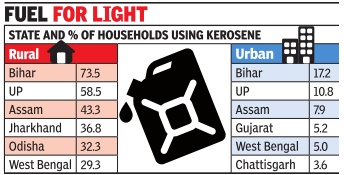
Mahendra Singh
`Kerosene hardly used for cooking, key lighting source'
The latest survey released by the National Sample Survey Organization (NSSO) has revealed that in rural areas, subsidized kerosene was used in less than 1% of kitchens, which relied largely on firewood and chips as the primary source of energy for cooking during 2011-12. After firewood (67% share), cooking gas cylinders have emerged as the second most preferred kitchen fuel in rural areas, with a share of 15%. In urban areas, of course, they now fire over 68% of the stoves, while the share of kerosene is estimated at 5.7%, lower than firewood (14%).
But when it comes to lighting homes in villages, the share of kerosene is estimated at 26.5%, with electricity's share estimated at 72.7%. In urban India, 3.2% of households uses kerosene for lighting while the share of electricity is 96%.
The data points to what several economists have argued for years: there is reduced dependence on kerosene despite the government doling out subsidized fuel, which is suspected to be used in large quantities for adulteration or finds its way into the open market, where there is no subsidy .
Currently , the government pays Rs 18.51 as subsidy for every litre of kerosene sold through the public distribution system. The underrecovery on the sale of kitchen fuel by the oil marketing companies added up to Rs 24,800 crore during the last financial year, with the government taking over around Rs 5,000 crore of the burden and forcing the state-run companies to bear the additional burden. But the findings of the NSSO survey showed wide divergence in fuel used across states such as Bihar and Uttar Pradesh still relying on dung cake and firewood to a large extent. The use of firewood and chips for cooking has declined, but slowly , over the years in rural India. It declined from 78.2% of all rural households in 1993-94 to 67.3% in 2011-12. LPG use in rural households has grown relatively fast, from fewer than 2% of rural households two decades ago to 15% in 2011-12. Cow-dung cake remained one of the major fuels for cooking for rural households in Ut tar Pradesh (33.4%) followed by Punjab (30.3%), Haryana (24%) and Bihar (20.8%).
Tamil Nadu had the highest use of LPG among rural households, with over a third using it for cooking, followed by Kerala and Punjab. The use of LPG was least in Chhattisgarh (1.5%) followed by Jharkhand (2.9%) and Odisha (3.9%).
When it comes to lighting, 73.5% of rural households in Bihar still use kerosene as primary source of energy for lighting, followed by Uttar Pradesh (58.5%) and Assam (36.8%).
Bihar also tops the chart when it comes to use of kerosene for lighting in urban areas with 17.2% of households still depending on kerosene.Followed by Bihar were Uttar Pradesh (10.8%), Assam (7.9%), Gujarat (5.2%) and West Bengal (5%).
The use of electricity was the highest in rural Andhra Pradesh, Punjab, Tamil Nadu and Kerala, where nearly all rural households used electricity to light their homes. In contrast, just 25.8% of rural Bihar and 40.4% of rural Uttar Pradesh households had electricity .
Prices
Change in the price of oil, petroleum, diesel, natural gas
2002-16
See graphic: The difference between the prices of diesel and petrol, 2002-16


2006–2014
2013-16
See graphic
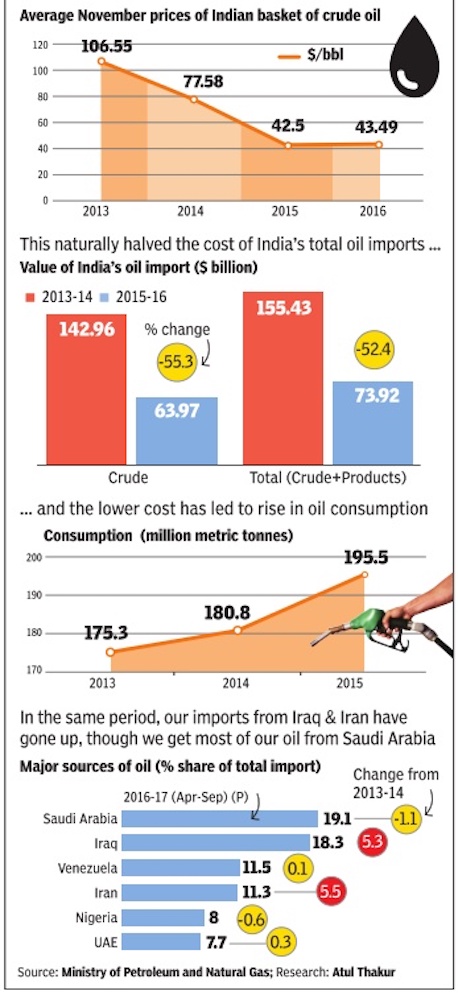
2015
Mar 26 2015
The basic price of petrol and the excise duty levied by the central government is uniform across the country. The final retail prices, however, vary from state to state depending on the state-level VAT, sales tax, local freight, delivery charges and so on. A comparison of 33 markets in different states shows that petrol is cheapest in Port Blair where it costs Rs 54.1 a litre, about 14 rupees cheaper than in Hyderabad where the rate is highest. Port Blair again has the cheapest diesel, with prices there 10 rupees lower than in Mumbai, which has the most expensive diesel in the country.
2016: crude price lowest in 12 years
The Times of IndiaJan 09 2016
TIMES NEWS NETWORK
It's yesterday once more! The price of crude bought by Indian refiners slumped to its lowest level in nearly 12 years, renewing hopes of continued reduced pump prices for consumers. It has also created room for government to raise fuel taxes to prop up the central kitty . However, it could also spark fresh worries of inventory losses for oil company bosses.
The mix of crude that India buys, called the `Indian basket', slumped after the European benchmark Brent slipped to its lowest in 13 years on worries over a slowdown in China, the second biggest oil consumer, amid oversupply .
For India, which imports 80% of its crude requirement, the happy hour also carries a statutory warning over currency and export woes.
The upside of low oil prices comes from forex savings on crude import. The savings are estimated at Rs 2 lakh crore this year. Latest data projects a 35% drop in the oil import bill at $73 billion against $112 billion last year, for nearly the same quantity . This is in addition to reduced subsidy for cooking fuels.
To put the savings in per spective, it would be enough to cover the Centre's school education, health, women and child development budgets, and pay for the rural jobs scheme. The government may also utilize this window to mop up additional resour ces by going for another round of excise hike on fuels. Signs of stability in global markets helped the domestic equities break a four-session losing streak but failed to stop the BSE sensex from logging its worst weekly performance since November 2011.
The benchmark BSE sensex rose by 82.5 points to recover from 19-month lows on Friday but on a weekly basis tumbled by 1,226.6 points or 4.7% on concerns over the health of Chinese economy and geopolitical tensions between Saudi Arabia and Iran.
See also
Petroleum, diesel, natural gas, India: I
Petroleum, diesel, natural gas, India, II (ministry data)

